Given that many wild roses are centuries old, they frequently conjure up images of knights, monarchs, queens, princes, and princesses from the Middle Ages. They are referred to as species roses in botany. Although this phrase doesn’t evoke the same feelings, it is the categorization used in rose catalogs and nurseries where you may find them advertised or offered for sale.
In this guide, we’ll explore everything you need to know about the many kinds of wild roses, how to cultivate them in gardens, and a few varieties to look out for.

Where Do Wild Roses Grow?
Knowing more about them, especially the locations where wild roses thrive is helpful in correctly growing wild rose plants. Wild roses or species of roses are plants that develop spontaneously in nature without any human assistance.
Wild species roses are solitary bloomers with five petals; nearly all of them are pink, with a small number of white, red, and even those that lean toward yellow. Growing wild roses are all “own root” roses, which means they develop from their own root systems without the need for grafting, which certain modern rose varieties rely on to thrive in various climatic circumstances. In actuality, wild roses occupy a particular place in the minds and hearts of every Rosarian since they are the roses from which all those we have today were produced. Wild roses are particularly resilient and have a tendency to flourish under conditions of neglect. Almost every type of soil may support the growth of these hardy roses, and at least one of them is known to thrive in moist soil.
If left on the bushes, these exquisite roses will yield lovely rose hips that last into the winter and offer food for the birds. They are self-rooting bushes, so even if they completely wither in the winter, the lovely rose that sprouts from the root will still be there.
How to Spot Wild Roses
Wild roses may be distinguished by the number of petals on the blossom and by the color, shape, and blooming pattern of their leaves.
You must examine the bushes of a certain type of rose if you want to learn more about it. While other rose, varietals have an arch, wild roses often have rigid, straight stems. They develop in bright light and partial shade, so you can recognize them by how they grow.
Additionally, some species only have a few thorns, while others have many. Thorns are abundant in wild roses, especially close to the blooms. You may also determine what sort of species they are by looking at the ecology in which they will flourish. For instance, if they reside near a sandy beach, a mountaintop, or an especially dry or muddy region, they could very well be wild roses.
Looking at the texture and form of the leaves is another method for identifying wild rose plants. Typically, a single stem of wild rose leaves has many leaflets. There is a large leaf nearby with three or smaller leaves. The leaf surface is ridged or flat, and the edges are serrated.
Keep a watchful eye on the rose’s blooming period. Do they only bloom once a year in the summer, or do they also bloom in the late summer? Most likely, you’re not looking at a wild rose if this occurs. You could be looking at a developed variety that has become unruly.
Look at the number of petals and the petals themselves. Wild roses often only have five petals. Its aroma can range from being overpowering to being virtually undetectable. Both directions are possible. Watch how they grow as well. They occasionally emerge as singles or in a spray.
How to Grow Wild Roses
The cultivation of wild rose bushes is not difficult. Wild rose bushes can be planted like regular rose bushes and generally thrive in locations with lots of sunlight and well-drained soil. Rosa palustris, popularly known as the swamp rose, is one variation that thrives in moist soil.
Avoid crowding wild roses while planting them in your rose beds, gardens, or overall landscape. All varieties of wild roses require space to spread out and reach their full potential. Like other rosebushes, when they are crowded, the air movement through and around the bushes is reduced, exposing the plants to disease issues.
These hardy rosebushes will flourish with the least amount of wild rose care after their root systems are established in their new locations. They actually don’t need to be deadheaded, and doing so will reduce or even stop them from producing their exquisite rose hips. They may be lightly trimmed to keep the appropriate form, but if you want gorgeous rose hips in the future, limit how much you do of this.
Now that we know everything about wild roses let’s look at a few species and varieties of wild roses.
Types of Wild Roses
1. The Bristly Rose
Botanical Name: Rosa nutkana
These wild roses boast pink, inch-wide blossoms. This kind is frequently found near or on slopes, including those that are accessed by roads. They can be found from southern Alaska to the coast of northern California, east to Montana in the north, and northern New Mexico in the south. The bristly rose may reach heights of up to nine feet in general.
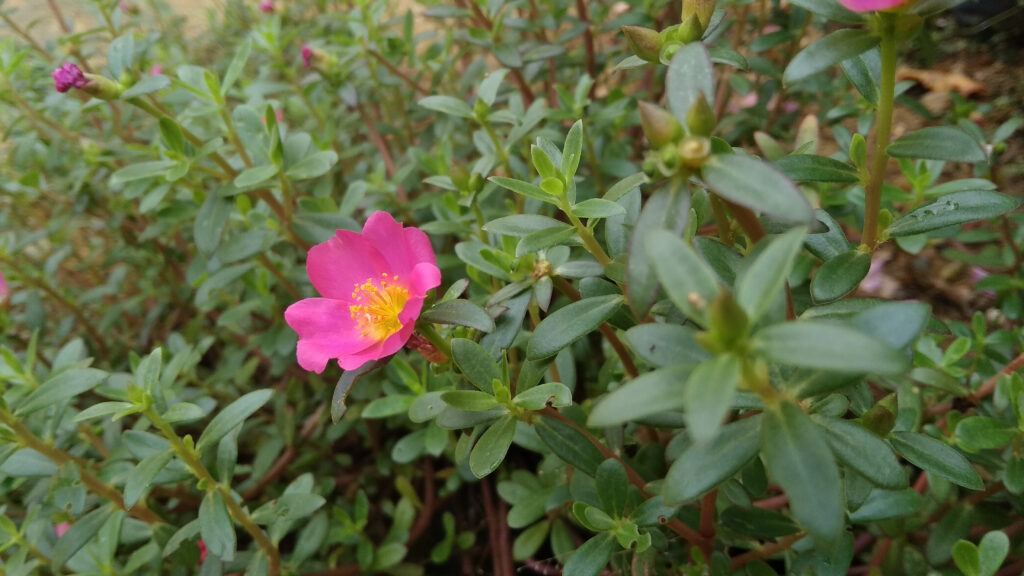
The
Rosa nutkanarose (pictured) can be found abundantly throughout the United States.
©RasyidArt/Shutterstock.com
2. The Wood’s Rose
Botanical Name: Rosa woodsii
Flowers on these roses range in color from white to dark red. Dense thickets up to four or five feet high can be seen with both the nutkana and woodsii types. Keep a mind that some kinds can grow quite thickly when planting them. Working through a jungle of thorns is not exactly fun nor easy, so spread out your woodsii patches as much as you can. Provide more space between plants than you would for modern rose types. They’ll swiftly fill that area if you don’t make a proactive trimming commitment.
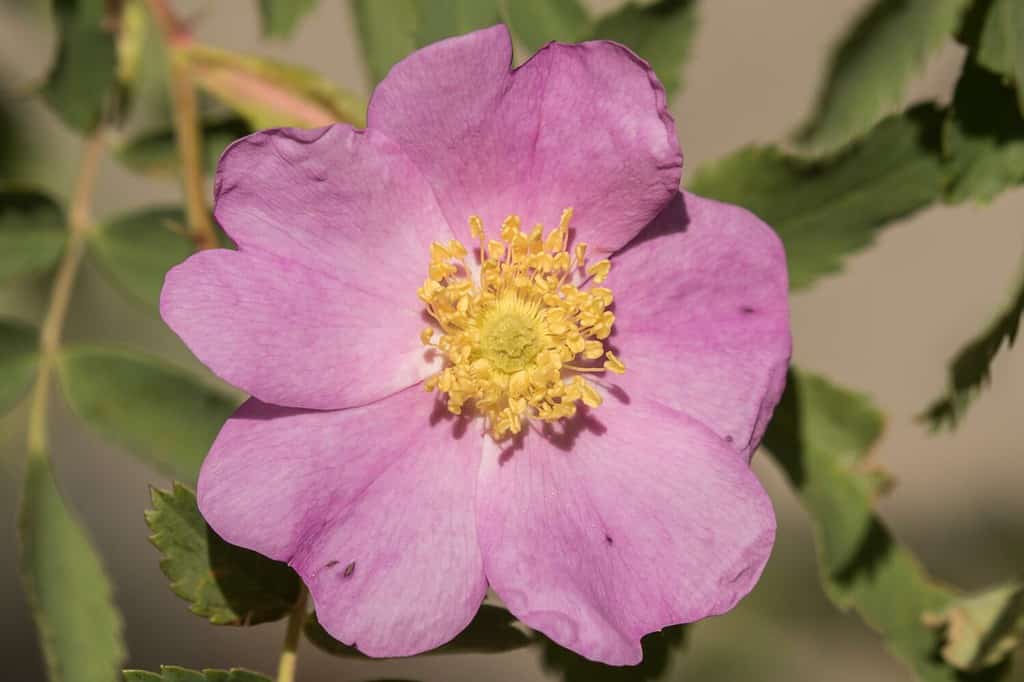
The Wood’s Rose grows in dense thickets up to five feet high.
©Northwest Wild Images/Shutterstock.com
3. The Seven Sisters Rose
Botanical Name: Rosa multiflora
The Multiflora rose, often called the Seven Sisters rose, is a robust perennial shrub that belongs to the old rose family. Its canes can grow up to ten feet in height and root at the tips. Other thornless varieties are rare in the eastern United States, whereas the red-to-green twigs occasionally bear multiple recurved thorns. Its saw-toothed leaflets and pinnately complex leaves develop in alternation. This ancient species is invasive in most of the United States, though their large clustered booms are quite beautiful.

The Seven Sisters rose is a robust perennial shrub.
©ASGOLD/Shutterstock.com
4. Carolina Rose
Botanical Name: Rosa Carolina
The Carolina rose, sometimes known as the pasture rose, is a low-growing shrub that is typically erect but may spread if the plants reach a height of more than three or four feet. It produces a profusion of two to three-inch wide brilliant pink blooms with yellow centers in the early summer. Although this native rose grows more shade tolerant than others, the flowers are more numerous in full sun. The stems are spiky with straight needle-like thorns, while the leaves are strongly serrated and dark green. This rose can withstand severe drought because of its thick taproot. It may also expand vegetatively to create tiny colonies and develops shallow rhizomes.
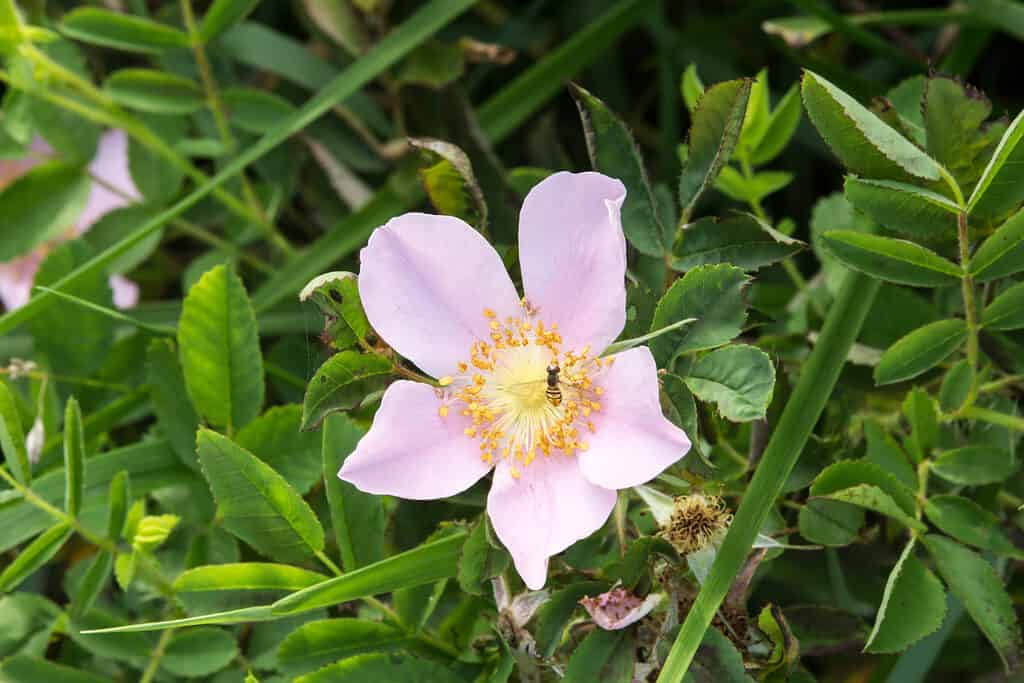
The Carolina rose (pictured) is a true classic wild rose that can grow quite tall.
©Kimberly Boyles/Shutterstock.com
5. Pomifera Rose
Botanical Name: Rosa villosa or Rosa pomifera
This delightful medium-sized shrub grows to a height of four to six feet. It has showy, single pink flowers in the summer, followed by an abundant crop of extra-large red fruits that are up to an inch in diameter and are an excellent source of vitamin C. The lovely leaves turn a soft yellow in the fall. It often flourishes in USDA hardiness zones four and higher.
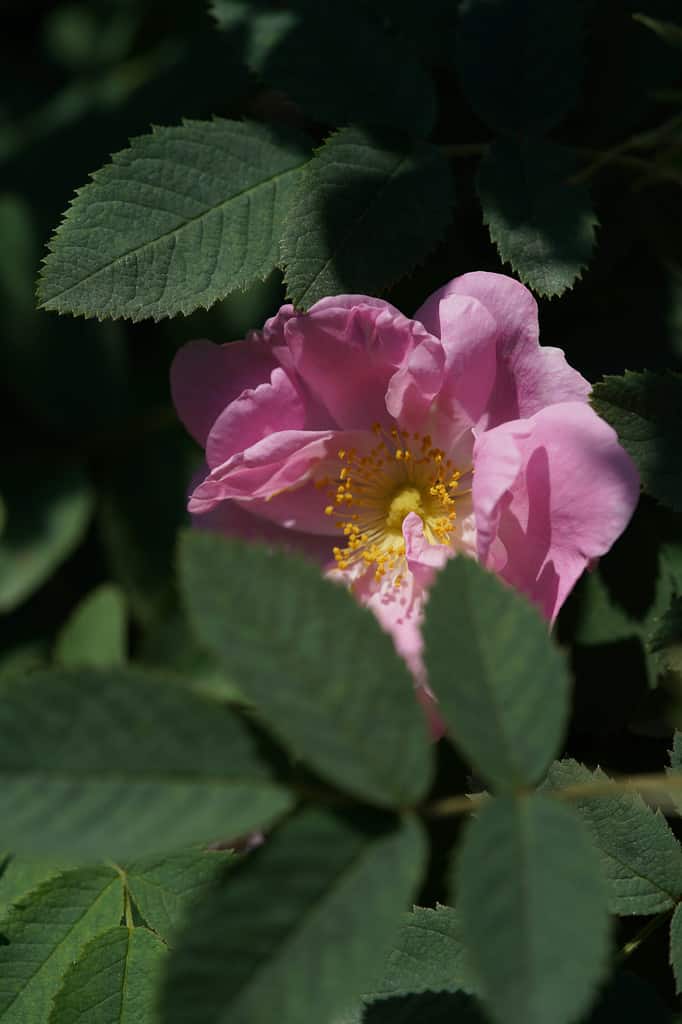
The Pomifera Rose is a medium-sized shrub with single pink flowers.
©MasterChefNobu/Shutterstock.com
6. Sweetbriar Rose
Botanical Name: Rosa eglanteria or Rosa rubiginosa
The sweetbriar rose is a thick, prickle-covered deciduous shrub that grows to a height and width of 10 feet. The greenery smells strongly like apples. The three-inch long, pinnately compound leaves have many glandular hairs and five to nine rounded leaflets with serrated margins. The blooms are produced in clusters of up to seven together from late spring to mid-summer. They have five pink petals with a white base and many yellow stamens.
This rose is endemic to much of Europe, where it lives in meadows and thorny plants from the montane to the subalpine plain in a sunny, continental environment. It is rarely found far north on the continent. This rose is quite rare, with solitary examples found beside highways and in fields where cattle frequently graze. It is prized for its aroma and the hips that develop after the blooms and last far into the winter in addition to its pink blossoms.

The Sweetbriar Rose’s greenery smells like apples.
©herryN/Shutterstock.com
7. Swamp Rose
Botanical Name: Rosa palustris
The swamp rose is an upright shrub that typically grows between six and eight feet tall and has multiple bushy stems with thorns. It boasts dazzling but fleeting dark rose-pink blooms and dark green, pinnately complex leaves. It is a shrub with pink flowers and thick, hooked thorns. You’ll find this in wetter areas as it loves very moist soil.
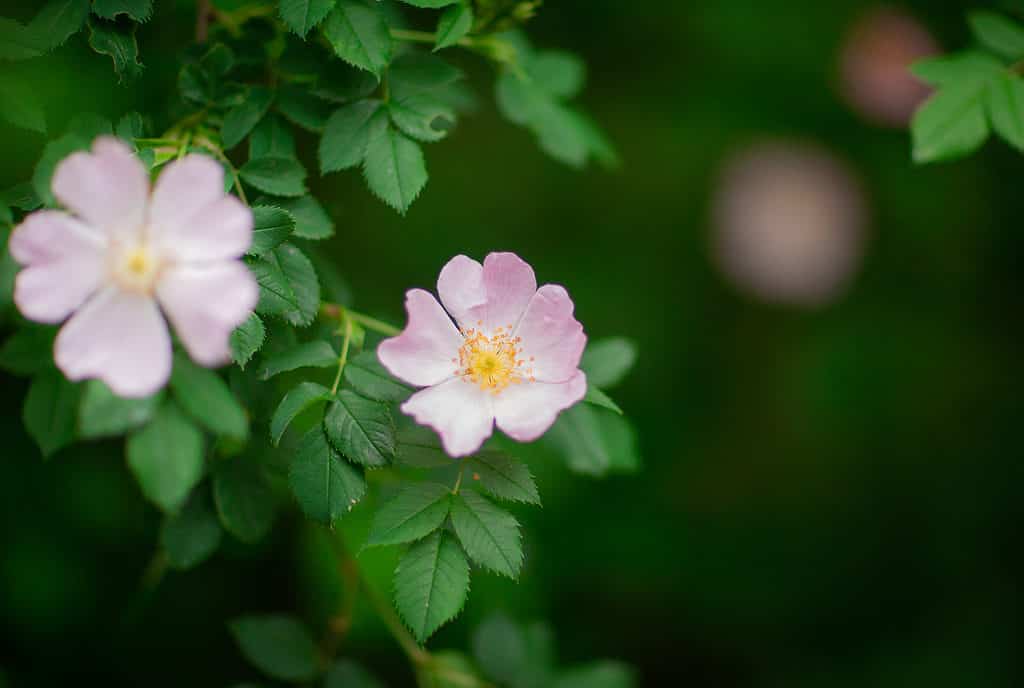
Swamp roses (pictured) have vibrant green foliage that is easy to spot.
©HBRH/Shutterstock.com
8. Apothecary Rose
Botanical Name: Rosa gallica officinalis
This is a special traditional rose that medieval herbalists in Europe utilized. It boasts deep pink semi-double flowers with big petals that are surrounded by golden stamens. The apothecary rose features an early summer bloom and short, rounded hips in the fall. It grows into a small, matte-green shrub at maturity that is three to four feet tall.
Hardiness zones four and higher are typically suitable for this rose’s natural growth. The ruby pink blooms of this low-growing, bristly shrub are quite fragrant. This is a classic rose used in medicine and perfumes. When you think of the traditional rose scent, you might just be thinking of the Apothecary rose’s scent. For potpourri, the big petals dry well and smell as lovely as fresh. If given enough space, this species will spread once planted in a garden. The roots of new shoots will extend out and grow. When discovered early, they are simple to remove but be careful of the many tiny thorns that are typical of wild roses.
These wild rose varieties are very special, and they grow quite well in gardens. Just make sure your garden is located in the proper USDA hardiness zone for your specific rose, and you’ll have some seriously special flowers blooming in your garden for years to come.
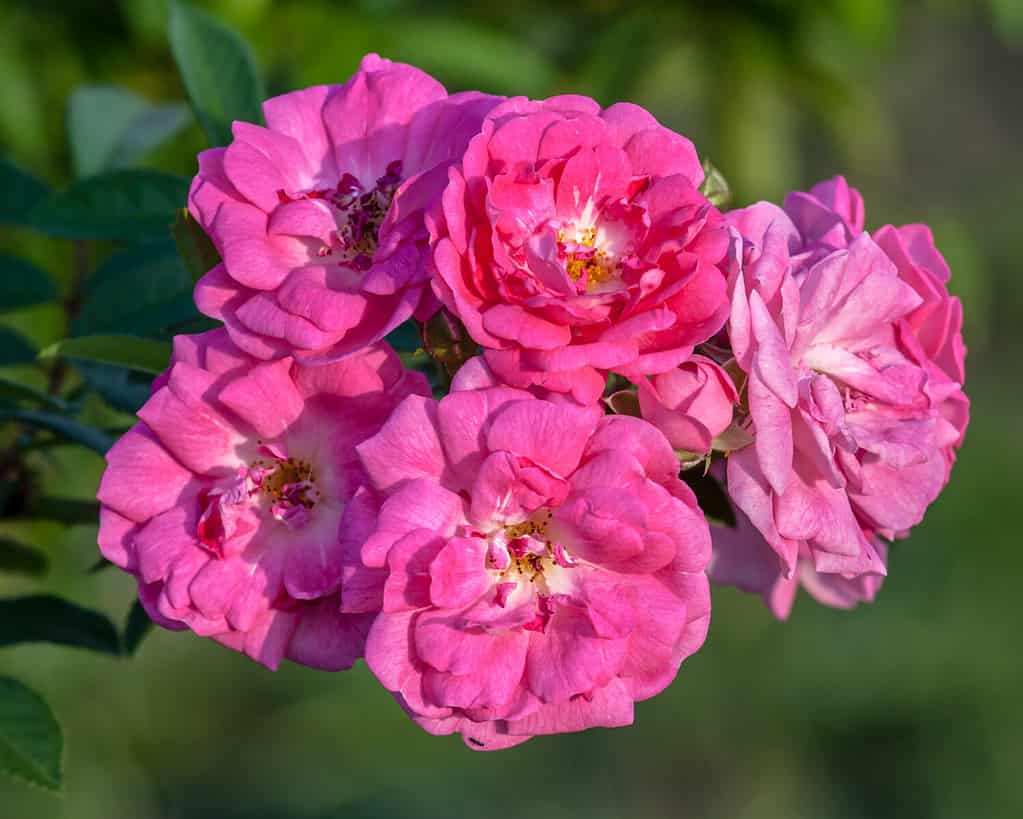
The Apothecary rose’s scent is used in perfumes and potpourri.
©SJ Allen/Shutterstock.com
Summary of 8 Types Of Native Wild Roses for Your Garden
| # | Rose | Appearance |
|---|---|---|
| 1 | The Bristly Rose | Pink, inch-wide blossoms |
| 2 | The Wood’s Rose | White to red blooms in dense thickets up to five feet high |
| 3 | The Seven Sisters Rose | Pink blossom clusters grow on a robust perennial shrub |
| 4 | Carolina Rose | Pink blossoms with yellow centers |
| 5 | Pomifera Rose | Medium-sized shrub features single pink flowers |
| 6 | Sweetbriar Rose | Thick shrub with pink flowers and leaves that smell like apples |
| 7 | Swamp Rose | Upright shrub with dazzling dark rose-pink blooms and dark green, pinnately complex leaves |
| 8 | Apothecary Rose | Deep pink semi-double flowers with big petals and a classic rose scent |
The photo featured at the top of this post is © Brookgardener/Shutterstock.com
Sources
- NCSU Staff, Available here: https://plants.ces.ncsu.edu/plants/rosa/
- Sheryl Geerts, Available here: https://www.bhg.com/gardening/flowers/roses/ultimate-rose-care-guide/
- Ray Allen, Available here: https://www.americanmeadows.com/the-wild-roses
FAQs (Frequently Asked Questions)
Is there a difference between wild roses and regular roses?
Cultivated roses are often healthier and more resistant to disease. Wild roses are more susceptible to disease, but they are more fire-resistant and have more aggressive root systems.
Are wild roses considered real roses?
Wild roses are indeed real roses and serve as the original roses that modern-day cultivated varieties were bred from.
How can I identify a wild rose?
Wild roses have curved thorns, pinnate leave, up to nine leaflets, and symmetrical flowers that are usually just white, cream, or pink.
Thank you for reading! Have some feedback for us? Contact the AZ Animals editorial team.






